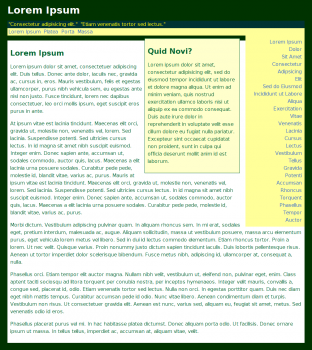When Latin is Used for Greeking: “Lorem Ipsum” Posted by Brittany Britanniae on Aug 9, 2016 in Latin Language, Roman culture, Uncategorized
Salvete Omnes! This week we’re going to talk about another modern use of Latin. This use is easy to miss, and, in fact, it was meant to be missed.

Example of Lorem Ipsum Used in Wed Design (Courtesy of Wikimedia Commons)
Also known as “Dummy Text”, the passage beginning with “Lorem Ipsum” is something that most internet users have seen at one point. When you’re setting up a new blog, looking at preview of webpage layouts, or maybe you recognize the first phrase from word document programs and their font previews. Anywhere you’ve seen it, you might have noticed that it was a block strange text used to fill out the fake pages. This text is meant to go unnoticed as your attention is drawn to the graphic design of the page. The word breaks of a Latin passage look much more natural than simply repeating “Content goes here. Content goes here”, etc.
Basically, this is the use of the following passage of text:
“Lorem ipsum dolor sit amet, consectetur adipiscing elit, sed do eiusmod tempor incididunt ut labore et dolore magna aliqua. Ut enim ad minim veniam, quis nostrud exercitation ullamco laboris nisi ut aliquip ex ea commodo consequat. Duis aute irure dolor in reprehenderit in voluptate velit esse cillum dolore eu fugiat nulla pariatur. Excepteur sint occaecat cupidatat non proident, sunt in culpa qui officia deserunt mollit anim id est laborum.”
Did you try and read that?
Don’t worry, your Latin isn’t that rusty. This passage, through the years, has gotten jumbled and edited in ways that make is nonsense!
If you’re truly, impressively, committed to your Classic literature, you might recognize bits and pieces of this passage from Cicero’s “de Finibus Bonorum et Malorum” (“The Extremes of Good and Evil”) written in 45 BC.

Sketch of Bust of Cicero, 1885. (Courtesy of Wikimedia Commons)
The real passage, however, is very different.
Here’s the original from Section 1.10.32:
“Sed ut perspiciatis unde omnis iste natus error sit voluptatem accusantium doloremque laudantium, totam rem aperiam, eaque ipsa quae ab illo inventore veritatis et quasi architecto beatae vitae dicta sunt explicabo. Nemo enim ipsam voluptatem quia voluptas sit aspernatur aut odit aut fugit, sed quia consequuntur magni dolores eos qui ratione voluptatem sequi nesciunt. Neque porro quisquam est, qui dolorem ipsum quia dolor sit amet, consectetur, adipisci velit, sed quia non numquam eius modi tempora incidunt ut labore et dolore magnam aliquam quaerat voluptatem. Ut enim ad minima veniam, quis nostrum exercitationem ullam corporis suscipit laboriosam, nisi ut aliquid ex ea commodi consequatur? Quis autem vel eum iure reprehenderit qui in ea voluptate velit esse quam nihil molestiae consequatur, vel illum qui dolorem eum fugiat quo voluptas nulla pariatur?”
And here is the the 1914 translation by H. Rackham:
“But I must explain to you how all this mistaken idea of denouncing pleasure and praising pain was born and I will give you a complete account of the system, and expound the actual teachings of the great explorer of the truth, the master-builder of human happiness. No one rejects, dislikes, or avoids pleasure itself, because it is pleasure, but because those who do not know how to pursue pleasure rationally encounter consequences that are extremely painful. Nor again is there anyone who loves or pursues or desires to obtain pain of itself, because it is pain, but because occasionally circumstances occur in which toil and pain can procure him some great pleasure. To take a trivial example, which of us ever undertakes laborious physical exercise, except to obtain some advantage from it? But who has any right to find fault with a man who chooses to enjoy a pleasure that has no annoying consequences, or one who avoids a pain that produces no resultant pleasure?”
This use of Latin is little understood and, in fact, it has been clumped with a larger practice called, ironically, “Greeking”.
However, this passage has a history that reaches far far back before the blogging phenomenon, before the advent of creating web-page designs, back before the internet.
In fact, using the Lorem Ipsum passage has been used as dummy text for centuries!
Lorem Ipsum has been used since the 1500’s. Apparently, Cicero’s “de Finibus Bonorum et Malorum” was a very popular text during the Renaissance and when bookbinding became a more common practice they would use this jumbled passage to fill in the pages to show the layout of the book without distracting the buyer, just in the same manner as we use it today.
The Lorem Ipsum passage is a fascinating example of how Latin and its uses have evolved into modern times and the interesting places you can still find it in this new era!
Sources:
http://www.lipsum.com/
http://www.business2community.com/marketing/marketingspeak-greeking-latin-01582889#53BOcGUSYkpD6pjF.97

Build vocabulary, practice pronunciation, and more with Transparent Language Online. Available anytime, anywhere, on any device.
About the Author: Brittany Britanniae
Hello There! Please feel free to ask me anything about Latin Grammar, Syntax, or the Ancient World.



